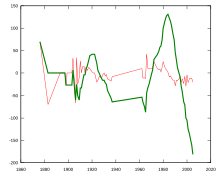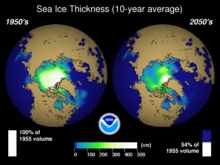glaciology
Glaciology is the science of the forms, occurrences and properties of ice and snow, including their formations as glaciers , permafrost and ice shelves . It originated in Switzerland in the 19th century as a glacier science .
Disciplines

Glaciology is an interdisciplinary science that touches several earth and life sciences :
At the same time, it is one of the most important disciplines in polar research and a data source for climatology .
The presence of ice on Mars and on various moons of the planets of the solar system also gives this science an extraterrestrial component.
Individual areas of this science include:
- the Glazialmorphologie , which deals with the forms of ice formations, and therefore the branch of physical geography is
- the Glazialgeologie , which, deals with the deposits caused by glacier; it also belongs to geology
- the Historic glaciology , which documents the glacier history and reconstruction of historical glacier training runs
- Other departments examine the effects of glaciers on the climate , glacier prognoses, the contribution of glaciers to erosion , life forms and habitats on and in the ice, underground ice deposits and others.
- Important research methods include geodesy and photogrammetry , applied geophysics ( impact and geoseismics ) and meteorology .
In Germany, the Alfred Wegener Institute in Bremerhaven is a leading representative of glaciology, as well as the Commission for Glaciology in Munich ( Bavarian Academy of Sciences ), and in Switzerland the ETH Zurich . In Austria it is the University of Innsbruck , the University of Salzburg and the Alpine Club . Some Innsbruck institutes create the annual glacier report with the OeAV glacier measurement service . In numerous other countries, the subject is also processed by research institutes .
history

The "cradle of glaciology" stood on the Unteraar Glacier in the Bernese Oberland . It was there that the geologist Franz Joseph Hugi carried out his first studies. In 1840, under Louis Agassiz, the first "research station" was built under a boulder, the Hotel des Neuchatelois . Documentation of the condition of individual glaciers has been collected in the Alps for over a hundred years.
In 1891 glacier research began by the DuOeAV , from which today's ÖAV glacier measurement service emerged. The main focus here is length measurement.
On August 21, 1902, the glacier researchers Adolf Blümcke and Hans Hess succeeded in the Hintereisferner in the Ötztal, after many unsuccessful attempts, to drive a borehole 153 m deep down to the bottom of the glacier for the first time. The cost of the enterprise, which amounted to several thousand marks, was borne by the German and Austrian Alpine Association.
The term " Ice Age " was introduced in 1837 by Karl Friedrich Schimper .
See also
literature
- Edmund Blair Bolles: Ice Age. How a professor, a politician and a poet discovered the eternal ice , Berlin 2000, ISBN 3-87024-522-0
"On the history of research, especially Louis Agassiz, Charles Lyell and Elisha Kent Kane." -
Hansjürgen Müller-Beck : The Ice Ages. Natural history and human history , Munich 2005, ISBN 3-406-50863-4
"Brief introduction from the Beck series." - Josef Klostermann: The climate in the ice age , Stuttgart 1999, ISBN 3-510-65189-8
- Stefan Winkler : Glaciers and their landscapes - An illustrated introduction , Darmstadt 2009, ISBN 978-3-89678-649-4
- Peter Merian : About the theory of glaciers . In: Annals of Physics and Chemistry , Volume LX; from the report on the negotiations of the Natural Research Society in Basel, No. V, 1843, full text ( Wikisource )
Radio report
- Frank Grotelüschen: The crackling of the glaciers . in dradio “ Current Research ” on December 3, 2013
Web links
- Wilfried Haeberli, Hanspeter Holzhauser: Glaciology. In: Historical Lexicon of Switzerland .
- Glaciers online , introduction to glaciology using photos. Jürg Alean and Michael Hambrey
- Glaciology for Beginners , Alfred Wegener Institute for Polar and Marine Research (AWI)
- Homepage of the Commission for Glaciology of the Bavarian Academy of Sciences in Munich
- Glacier research in Austria , joint homepage of glacier research in Austria
- Glacier diary , current reports on Austria's glaciers
- World Glacier Monitoring Service , Faculty of Geography at the University of Zurich (English)
- Caltech Glaciology Group , Glaciology Group at CalTech (English)
- Polar Geophysics Working Group, Institute for Geophysics at the University of Münster
- Institute for Meteorology and Geophysics , University of Innsbruck
- Angelika Humbert unravels the eternal ice. Conversation with a glaciologist. Pulse. Current knowledge. SWR2. (Podcast from November 22, 2019)
Individual evidence
- ^ Glacier measurement service Austrian Alpine Association. In: alpenverein.at . Retrieved December 13 and 14, 2016.
- ^ Glaciology Austria. In: glaziologie.at. Retrieved December 14, 2016 .
- ^ Innsbrucker Nachrichten , September 17, 1902.
